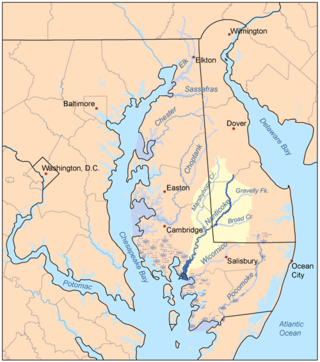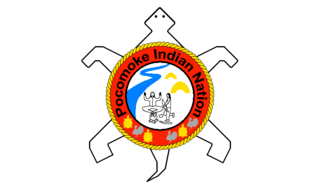Related Research Articles

The Delmarva Peninsula, or simply Delmarva, is a large peninsula and proposed state on the East Coast of the United States, occupied by the vast majority of the state of Delaware and parts of the Eastern Shore regions of Maryland and Virginia. The peninsula is 170 miles (274 km) long. In width, it ranges from 70 miles (113 km) near its center, to 12 miles (19 km) at the isthmus on its northern edge, to less near its southern tip of Cape Charles. It is bordered by the Chesapeake Bay on the west, Pocomoke Sound on the southwest, and the Delaware River, Delaware Bay, and the Atlantic Ocean on the east.

Somerset County is the southernmost county in the U.S. state of Maryland. As of the 2020 census, the population was 24,620, making it the second-least populous county in Maryland. The county seat is Princess Anne.

The Lenape, also called the Lenni Lenape and Delaware people, are an indigenous people of the Northeastern Woodlands, who live in the United States and Canada. The Lenape's historical territory included present-day northeastern Delaware, all of New Jersey, the eastern Pennsylvania regions of the Lehigh Valley and Northeastern Pennsylvania, New York Bay and western Long Island, and the lower Hudson Valley.

The Powhatan people may refer to any of the Indigenous Algonquian people that are traditionally from eastern Virginia. All of the Powhatan groups descend from the Powhatan Confederacy. In some instances, The Powhatan may refer to one of the leaders of the people. This is most commonly the case in historical records from English colonial accounts. The Powhatans have also been known as Virginia Algonquians, as the Powhatan language is an eastern-Algonquian language, also known as Virginia Algonquian. It is estimated that there were about 14,000–21,000 Powhatan people in eastern Virginia, when English colonists established Jamestown in 1607.

The Nanticoke people are a Native American Algonquian people, whose traditional homelands are in Chesapeake Bay and Delaware. Today they live in the Northeastern United States and Canada, especially Delaware; in Ontario; and in Oklahoma.
Turkey Tayac, legally Philip Sheridan Proctor (1895–1978), was a Piscataway leader and herbal medicine practitioner; he was notable in Native American activism for tribal and cultural revival in the 20th century. He had some knowledge of the Piscataway language and was consulted by the Algonquian linguist, Ives Goddard, as well as Julian Granberry.

The Piscataway or Piscatawa, are Native Americans. They spoke Algonquian Piscataway, a dialect of Nanticoke. One of their neighboring tribes, with whom they merged after a massive decline of population following two centuries of interactions with European settlers, called them the Conoy.
The Nanticoke Lenni-Lenape people are a tribal confederation of Nanticoke of the Delmarva Peninsula and the Lenape of southern New Jersey and northern Delaware. They are recognized by the state of New Jersey, having reorganized and maintained elected governments since the 1970s. They have not yet achieved federal recognition.

The Doeg were a Native American people who lived in Virginia. They spoke an Algonquian language and may have been a branch of the Nanticoke tribe, historically based on the Eastern Shore of Maryland. The Nanticoke considered the Algonquian Lenape as "grandfathers". The Doeg are known for a raid in July 1675 that contributed to colonists' uprising in Bacon's Rebellion.
Fairmount Wildlife Management Area is a Wildlife Management Area in Somerset County, Maryland. The wildlife management area comprises more than 4,000 acres (1,600 ha) of mostly marshland. It is located on the Eastern Shore of Maryland along the Chesapeake Bay between the Manokin and Annemessex Rivers in Somerset County. American black duck, northern pintail, gadwall, American wigeon, blue and green-winged teal, and many other species of waterfowl can be found in the area.
Tangier Sound is a sound of the Chesapeake Bay bounded on the west by Tangier Island in Virginia, and Smith Island and South Marsh Island in Maryland, by Deal Island in Maryland on the north, and the mainland of the Eastern Shore of Maryland and Pocomoke Sound on the east. It stretches into Virginia as far south as Watts Island.
The Choptank were an Algonquian-speaking Native American people that historically lived on the Eastern Shore of Maryland on the Delmarva Peninsula. They occupied an area along the lower Choptank River basin, which included parts of present-day Talbot, Dorchester and Caroline counties. They spoke Nanticoke, an Eastern Algonquian language closely related to Delaware. The Choptank were the only Indians on the Eastern Shore to be granted a reservation in fee simple by the English colonial government. They retained the land until 1822, when the state of Maryland sold it, in part to pay for the state's share of the District of Columbia.
The Assateague were an Algonquian people speaking the Nanticoke language who historically lived on the Atlantic coast side of the Delmarva Peninsula.
The Accomac people were a historic Native American tribe in Accomack and Northampton counties in Virginia. They were loosely affiliated with the Powhatan Confederacy.

The land that is now the State of Maryland in the United States of America was widely populated by indigenous tribes prior to European arrival, however only 1.0% of the state's population self-reported as Native American in the 2010 United States Census. Native Americans have inhabited the area since c. 10,000 BC.
The Annamessex people were a historic Native American tribe from the Eastern Shore of Maryland. Their homelands were part of present-day Somerset County, Maryland.

The Pocomoke Indian Nation is a cultural heritage organization of individuals who identify as descendants of the Pocomoke people. They formed a nonprofit organization, the Pocomoke Indian Nation, Inc., in Eden, Maryland.
References
- Feest, Christian F. (1978). Trigger, Bruce G. (ed.). Handbook of North American Indians: Northeast, Vol. 15. Washington, DC: Smithsonian Institution. pp. 240–48.